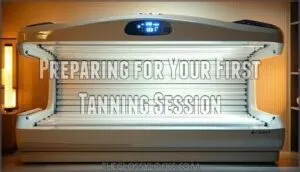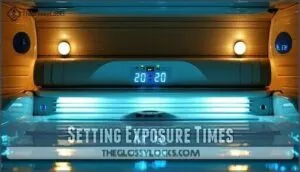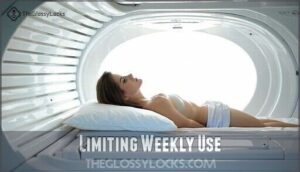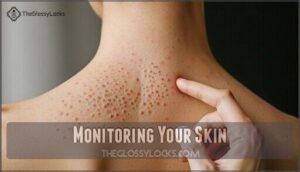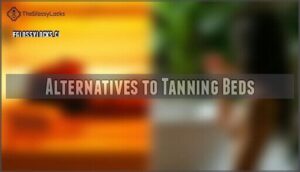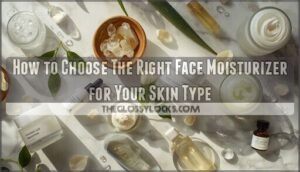This site is supported by our readers. We may earn a commission, at no cost to you, if you purchase through links.
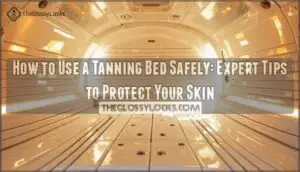
Always wear FDA-approved goggles to protect your eyes from UV damage. Start with sessions under 10 minutes, especially if you’re fair-skinned.
Never tan daily – your skin needs time to recover between sessions. Apply SPF lip balm and cover tattoos or sensitive areas.
Don’t use tanning lotions with bronzers before your first visit, as they can cause uneven results. Most importantly, inspect your skin regularly for new moles or changes in existing ones.
Think of it as playing it safe while chasing that golden glow – there’s more to master than just timing. Remember to always prioritize your skin’s health and take necessary precautions to avoid UV damage and inspect for new moles.
Table Of Contents
- Key Takeaways
- How to Use a Tanning Bed Safely?
- Preparing for Your First Tanning Session
- Wearing Protective Gear
- Setting Exposure Times
- Minimizing Skin Damage
- Monitoring Your Skin
- Alternatives to Tanning Beds
- Frequently Asked Questions (FAQs)
- How do I use a tanning bed?
- Is it safe to tan in a tanning bed?
- What are the best tanning bed tips?
- Do tanning beds cause a tan?
- Can You Tan in a tanning bed without eye protection?
- How to get the most out of a tanning bed session?
- Is there any way to safely use tanning beds?
- What is 10 minutes on a sunbed equivalent to?
- How to use a tanning bed for beginners?
- Am I supposed to flip over in a tanning bed?
- Conclusion
Key Takeaways
- Start slowly and protect your eyes – Begin with 3-5 minute sessions based on your skin type and always wear FDA-approved tanning goggles to prevent UV eye damage and burns.
- Space out your sessions properly – Wait 24-48 hours between tanning sessions and never exceed 2-3 visits per week to give your skin time to recover and build tolerance safely.
- Cover sensitive areas and monitor your skin – Use protective coverings on nipples, lips, and tattoos, then check regularly for new moles, unusual spots, or changes that need medical attention.
- Consider safer alternatives – Try sunless tanning products like gradual lotions or professional spray tans, and take vitamin D supplements instead of relying on UV exposure for health benefits.
How to Use a Tanning Bed Safely?
Using a tanning bed safely starts with understanding your skin type and following proper tanning bed safety guidelines. Before stepping into any bed, check the bed cleaning protocols at your salon—cleanliness matters for your health.
Choose the right lotion choice based on your skin’s needs, and always wear fitted goggles to protect your eyes from UV damage. Cover sensitive areas like lips and tattoos to prevent burns.
Start with short sessions and never exceed recommended tanning bed usage times. These tanning bed precautions aren’t just suggestions—they’re your safety net against skin damage.
Focus on hydration importance by drinking plenty of water before and after sessions. To maximize your tan, remember to apply rich moisturizers after your session. Follow proper session aftercare by moisturizing your skin immediately afterward.
Monitor your skin for unusual moles or changes, and consult a doctor if something looks off. Remember, tanning bed safety means respecting both the equipment and your body’s limits.
Preparing for Your First Tanning Session
Getting ready for your first tanning session is like preparing for any new experience – proper planning helps you stay safe and get better results.
You’ll need to know your skin type and choose the right equipment before you step into that tanning bed, which is crucial for achieving the desired outcome with better results.
Choosing The Right Tanning Bed
Not all tanning beds are created equal.
Low-pressure beds offer gradual results, while high-pressure options deliver faster tans.
Vertical booths provide 360-degree coverage without claustrophobia concerns.
Check salon reputation through reviews and cleaning procedures.
Home beds cost more upfront but save money long-term.
Consider bed wattage, bulb quality, and safety features like cooling systems when selecting your ideal tanning bed type.
Understanding UVA and UVB Rays
Once you’ve picked your bed, you need to understand what you’re getting into.
UVA rays dig deep into your skin, causing long-term damage and cancer risks. UVB rays hit the surface harder, creating burns but also helping with vitamin D production.
Tanning beds blast you with intense UV radiation – both types. This ray balance affects your tanning bed safety and potential skin damage.
To mitigate potential harm, consider incorporating antioxidants for skin into your skincare routine.
Wearing Protective Gear
You’ll need proper protective gear to shield your most vulnerable areas from UV damage during tanning sessions.
Your eyes and sensitive skin areas require specific protection to prevent burns, irritation, and long-term health problems.
Fitted Goggles for Eye Protection
Your eyes need serious protection from UV rays during tanning sessions. Regular sunglasses won’t cut it – you need proper tanning goggles that block both UVA and UVB radiation.
Here’s what makes quality protective eyewear essential:
- Goggle types include disposable and reusable options with FDA-approved UV protection
- Proper fit means no light leaks around edges or pressure points
- UV protection blocks 99-100% of harmful rays to prevent cataracts and eye damage
- Hygiene practices require cleaning goggles after each use with disinfectant wipes
- Replacement frequency should follow manufacturer guidelines, typically every few months
Quality tanning goggles aren’t negotiable – your vision depends on them. Purchasing the best tanning goggles is vital for safety.
Covering Sensitive Areas
Beyond protecting your eyes, you’ll need to shield your most vulnerable spots.
Nude tanning exposes sensitive skin like nipples, lips, and genitals to intense UV rays. Use protective coverings or bandages on these areas to prevent burns and irritation.
Position breasts and genitals carefully to avoid overexposure while maintaining your desired tan lines.
| Body Area | Protection Method | Why It Matters |
|---|---|---|
| Nipples | Small stickers/bandages | Extremely sensitive tissue |
| Lips | SPF lip balm | Thin skin burns easily |
| Genitals | Protective covering | Delicate, rarely sun-exposed |
| Fresh tattoos | Complete coverage | Ink can fade/distort |
Setting Exposure Times
You’ll need to set your tanning time carefully based on your skin type to avoid burns and damage.
Start with short sessions of 3-5 minutes for fair skin or up to 10 minutes for darker skin types.
Then increase gradually as your skin builds tolerance.
Starting With Short Sessions
Why rush into longer sessions when your skin needs time to adapt? Start with brief tanning bed sessions to protect yourself from burns and damage.
- Initial Exposure: Begin with 3-5 minute sessions based on your skin sensitivity
- Session Frequency: Limit visits to 2-3 times weekly maximum
- Monitoring Results: Check skin condition after each session
- Tanning Bed Duration: Never exceed recommended time limits
To further protect yourself, consider using scalp-specific sunscreens even in tanning beds.
Gradually Increasing Exposure
Once you’ve mastered short sessions, it’s time to build your tan safely.
Increase your tanning bed time by 1-2 minutes per visit, allowing your skin tolerance to develop naturally.
This gradual progression prevents tanning bed burns while maximizing results.
Space sessions 24-48 hours apart to optimize session frequency and avoid overexposure.
Smart exposure timeframes protect your investment and your skin.
Minimizing Skin Damage
You can protect your skin from serious damage by controlling how often and how long you use tanning beds.
The key is avoiding intense sessions and limiting your weekly visits to give your skin time to recover between exposures, which is crucial for recover.
Avoiding Intense Exposure
Once you’ve set your exposure times, resist the urge to push boundaries.
Intense UV exposure limits your skin’s ability to adapt safely. Think of it like building muscle – you wouldn’t lift your heaviest weight on day one.
Follow these tanning bed guidelines to prevent burns:
- Limit Session Time to recommended minutes based on your skin type
- Recognize Burn Signs like redness, pain, or excessive heat during sessions
- Monitor Medication Sensitivity that increases UV vulnerability
Limiting Weekly Use
Limiting your tanning bed frequency protects against overexposure risks and allows proper skin recovery time.
Most experts recommend waiting 48-72 hours between sessions, never exceeding three times weekly. Your personalized tanning plans should prioritize safe tanning practices over quick results.
Understanding the importance of skin’s protective barrier is vital for maintaining healthy skin.
| Skin Type | Weekly Limit | Recovery Time |
|---|---|---|
| Fair (I-II) | 2 sessions max | 72 hours |
| Medium (III-IV) | 3 sessions max | 48 hours |
| Dark (V-VI) | 3 sessions max | 48 hours |
| Sensitive | 1-2 sessions | 72+ hours |
| First-time | 1 session | 72+ hours |
Monitoring Your Skin
Your skin changes over time, and regular tanning bed use makes it important to watch for new spots, moles, or unusual marks.
Your skin tells a story—make sure you’re listening to what it’s trying to say.
You’ll need to check your skin regularly and talk to a doctor if you notice anything that looks different or concerning.
Checking for Skin Cancer Signs
Regular skin health monitoring helps catch problems early, when they’re most treatable.
Look for the ABCDE warning signs: Asymmetry Check for uneven mole shapes, Border Irregularity around edges, Color changes, Diameter Increase beyond pencil eraser size, and Evolving Moles that change appearance.
Mole Changes happen gradually, so monthly self-exams help you spot differences in freckles and existing spots.
Reporting Concerns to a Doctor
When you spot mole changes, unusual spots, or experience persistent itch and delayed healing, don’t wait. Skin sensitivity after tanning bed use requires immediate medical attention from a healthcare professional.
Here’s your action plan:
- Document any new skin conditions or skin irritation with photos
- Schedule an appointment within days, not weeks
- Stop all tanning bed sessions until cleared by your doctor
Early detection saves lives when dealing with potential skin cancer.
Alternatives to Tanning Beds
You don’t need tanning beds to get a golden glow or maintain healthy vitamin D levels.
Self-tanning products and vitamin D supplements offer safer ways to achieve your goals without exposing your skin to harmful UV radiation.
Sunless Tanning Options
Sunless tanning offers a smart way to achieve that golden glow without the cancer risks.
These alternatives protect your skin while delivering beautiful results:
- Gradual tan lotions build color slowly for natural-looking results
- Spray tan sessions provide professional, even coverage in minutes
- Airbrush tanning creates flawless, customized color without streaks
Tanning lotions with DHA give you control over intensity.
Remember, sunless tanning options eliminate UV damage while still giving you that sun-kissed look you want.
Explore various sunless tanning products for superior results.
Vitamin D Supplements
While sunless tanning protects your skin, you still need vitamin D for bone health and immune function.
Many people don’t get enough from food sources alone, making supplements a smart choice for tanning bed safety.
| Vitamin D Type | Supplement Dosage | Food Sources |
|---|---|---|
| D2 (Ergocalciferol) | 600-800 IU daily | Fortified cereals, mushrooms |
| D3 (Cholecalciferol) | 600-800 IU daily | Fatty fish, egg yolks |
| Combined Sources | Varies by individual | Fortified milk, orange juice |
Watch for deficiency symptoms like fatigue and bone pain.
Consider purchasing Vitamin D to maintain healthy levels.
Check supplement interactions with medications before starting any vitamin D routine.
Frequently Asked Questions (FAQs)
How do I use a tanning bed?
Choose your bed type based on skin tone, apply indoor tanning lotion, wear eye protection, and start with short 3-10 minute sessions. Wait 24-48 hours between visits and moisturize afterward.
Is it safe to tan in a tanning bed?
Tanning beds aren’t safe despite claims otherwise.
You’re exposing yourself to concentrated UV radiation that damages skin cells and substantially increases melanoma risk.
Dermatologists recommend avoiding them entirely and choosing safer self-tanning alternatives instead, to substantially reduce the risk associated with tanning beds.
What are the best tanning bed tips?
Start with short sessions based on your skin type, wear protective eyewear, and apply indoor tanning lotion.
Wait 48 hours between sessions, moisturize daily, and never exceed recommended times to avoid burns.
Do tanning beds cause a tan?
Ironically, despite the name "tanning bed," you’re basically lying under artificial sunlight. Yes, UV rays penetrate your skin cells, triggering melanin production that creates that golden-brown color you’re after.
Can You Tan in a tanning bed without eye protection?
No, you shouldn’t tan without eye protection.
UV rays from tanning beds can damage your corneas, cause cataracts, and lead to permanent vision problems.
Always wear protective eyewear designed specifically for tanning beds.
How to get the most out of a tanning bed session?
Exfoliate beforehand, apply quality indoor lotion, position yourself evenly, and don’t exceed recommended time limits.
You’ll maximize results while protecting your skin—it’s about working smarter, not harder, for that perfect glow.
Is there any way to safely use tanning beds?
While tanning beds pose health risks, you can minimize harm by limiting sessions, wearing protective eyewear, choosing lower-pressure beds, moisturizing daily, and following salon guidelines for your specific skin type.
What is 10 minutes on a sunbed equivalent to?
Like a timer counting down summer days, ten minutes in a sunbed equals roughly two hours of natural sunlight.
Your skin absorbs concentrated UV rays faster than you’d expect, making those brief sessions surprisingly powerful.
How to use a tanning bed for beginners?
Start with just 3-5 minutes for your first session. Always wear protective eyewear and apply indoor lotion beforehand. Wait 24-48 hours between sessions. Know your skin type to avoid burns.
Am I supposed to flip over in a tanning bed?
Don’t put all your eggs in one basket—yes, you should flip over halfway through your tanning session.
Most beds require you to turn from back to stomach for even coverage and avoid patchy results.
Conclusion
Remember that mastering how to use a tanning bed safely requires patience and proper preparation.
You’ve learned the essential steps: wearing protective goggles, starting with short sessions, and monitoring your skin regularly.
Don’t rush the process or skip safety measures. Your skin’s health matters more than achieving a quick tan.
Follow these guidelines consistently, and you’ll minimize risks while getting the results you want, which will help with smart tanning habits today protect your skin for years to come.
- https://dermnetnz.org/topics/ban-the-tan/
- https://www.tandfonline.com/doi/full/10.1080/07315724.2015.1039866
- https://onlinelibrary.wiley.com/doi/full/10.1111/j.1529-8019.2009.01291.x
- https://www.goodlookingtan.com/disclaimer
- https://www.aad.org/public/diseases/skin-cancer/surprising-facts-about-indoor-tanning

